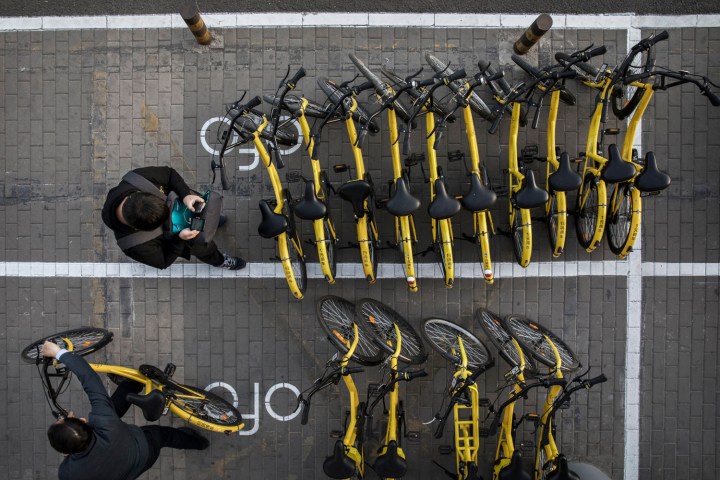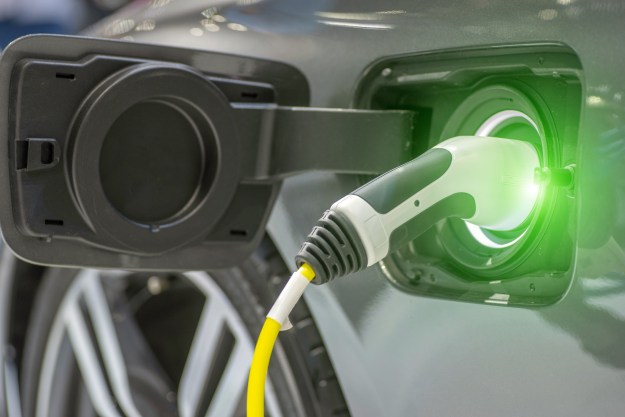
Shared bicycle systems of various kinds have been around for over 100 years, but until recently logistical and social issues have doomed almost all idealistic bike sharing efforts all over the world. Specifically, free bikes have been stolen and vandalized so frequently that bikeshare operators soon ran out of money and patience.
Worldwide, China has far more bikeshare opportunities than most countries, but they also have the most problems. The Chinese government has encouraged entrepreneurship in the bikeshare space, to help reduce traffic congestion and air pollution. In Beijing today, there are 15 different bikeshare companies fielding an estimated 2.35 million bicycles. The city of Guangzhou has 700,000 bikes in service, accounting for about 4 million trips per day.
However, the saturation of bicycles in some Chinese urban centers makes sidewalks and mass transit stations impassable. Chinese bikeshare users often abandon bikes in the street or on the sidewalk. Thousands of bikes have been seized and impounded by local authorities in an effort to keep Chinese cities from being buried in bikes.
European and American cities have also had their struggles, with dozens of bikeshare programs started and abandoned over the years. But that’s changing now, courtesy of the same technology that enables unattended short-term car rentals.
How modern bikeshare works
Motivate is the market leader in commercial bikeshare systems. The company currently operates bikeshare fleets in Boston, Chattanooga, Chicago, Columbus, Jersey City, New York, Portland, Washington D.C., and the San Francisco Bay Area.
Theft and vandalism nearly bankrupted bikeshare companies. Now riders have to have skin in the game.
To keep shared bikes under any kind of control, companies have to make sure the riders have skin in the game. Accountability is achieved through identification and financial responsibility. That’s why riders typically need a credit card and a smartphone app, or at least a verified member number, to rent a bike in a modern system.
When an available bike has been located, the rider reserves the bike and unlocks it either with the phone app, a card swipe, or an access code for that particular bike. The rider then uses the bike and returns it to any dock or approved alternate location and re-locks the bike. The rider is billed for the time used, plus a fee of a dollar or two if the bike is not returned to a docking station. The rider is responsible for damage to the bike, or for the full cost of the bike if it’s lost or stolen during the ride.
A typical bikeshare example
Portland, Oregon had a free bikeshare program called Yellow Bike in the 1990s. As in many other communities, the rate of theft and vandalism quickly killed Portland’s experiment. Now bikeshare is back on Portland streets, this time in a public-private partnership called Biketown. Biketown is a joint project of the Portland Bureau of Transportation, Nike, and Motivate.
“Theft is not a problem for us now,” says Tom Rousculp, Marketing Manager of Biketown. “We have a thousand bikes in our system. Over the year and a half that we’ve been operating, there are three bikes that we can’t find.”
It’s not that people in Oregon are more trustworthy now than they were 20 years ago. It’s technology.
“The real reason is that they all have GPS on them,” Rousculp reveals. “Every bike has LoJack because we need to know where it is. Riders can see where available bikes are locked through our app. But through the back end, we can see where every bike is in real time. We’ll actually get an alert if a bike has been out for longer than three hours on a single trip. We just need to know if the user has been taking a long ride around town or something.”
Having solved the big problems of theft and vandalism, Biketown also has to deal with the logistical challenges of a successful bikeshare program.
“We have a thousand bikes in our system. Over the year and a half that we’ve been operating, there are three bikes that we can’t find.”
“In the morning, people are riding in from the outskirts of downtown into the central city and you get the bikes piling up around these stations or around these transportation nodes,” Rousculp explains. “We have a group of employees whose job it is to rebalance the system. They go down in the morning and pick up the bikes and bring them back to the outlying stations. They make sure any given station is typically about half full. That way there is always a bike to take and always space for a bike to be left. Those are the big ongoing operational pieces that we do on a day-to-day basis.”
Part of rebalancing the system is picking up bikes that have been left away from Biketown docks.
“We have docking stations but our system allows you to lock to a bike rack or a stop sign, or to any kind of fixed object throughout the system area. That allows you the flexibility to not have to go to a Biketown station. There’s a $2 fee associated with parking away from a station in most areas of the city. But if you return a bike that was parked away from a dock, you get a $1 credit. That helps rebalance the system for us and we reward you for it.”
There’s no place like home
Programs like Biketown are the future of urban bikeshare, but free honor-based systems are still in use. One program that has been successful is Green Apple Bikes in Manhattan, Kansas. Manhattan is home to Kansas State University and has a population of about 55,000 people.

“I don’t know if it’s just how great of a town Manhattan is, or just that we got the luck of the draw with the volunteers that we have,” says Emily Gorman, Program Director of Green Apple Bikes. “It’s very informal. Our bikes are all free to everyone in the county for 24 hours, and then you can return it to a Green Apple bike rack, or a virtual rack. All that means is that it’s parked somewhere in public view, maybe on a street corner or in front of a building. If that bike isn’t currently being ridden, it’s considered to be in a virtual rack, and it is able to be used.”
“Our bikes are all free to everyone in the county for 24 hours, and then you can return it to a Green Apple bike rack”
Green Apple Bikes has had its share of unscrupulous riders, but Gorman believes they’re the exception.
“There’s a saying that, if you make something foolproof the world will invent a better fool,” Gorman jokes. “I’ve seen bike hoarding, and we’ve seen bikes that were purposely and maliciously destroyed, such as where the handlebars are dented or inverted, or chains are ripped off. We had an issue where our seats were getting stolen, so we ordered a new prototype for our next batch of bikes that makes the seat much more difficult to steal.”
Green Apple Bikes is also involved in a program that takes donated bikes and refurbishes them. Then they give the bikes to needy residents.
“Recipients are vetted out to make sure that they’ll take care of the bike,” Gorman explains. “They’re instructed on maintenance and they are provided a helmet and some general care guidelines.
“They’re also provided with $50 credit at the bike shop that does the refurbishing. They can take the bike in and utilize any of that $50 to make improvements or adjustments.”
The Green Apple project started small, but is growing steadily with the support of several local business sponsors.
Gorman says. “Our fleet right now is about 250 bikes,” Gorman says. “We started with 12 bikes in 2015 and we steadily increased it. We’re really looking to increase that number, so we purchased 400 new bikes this fall.”






